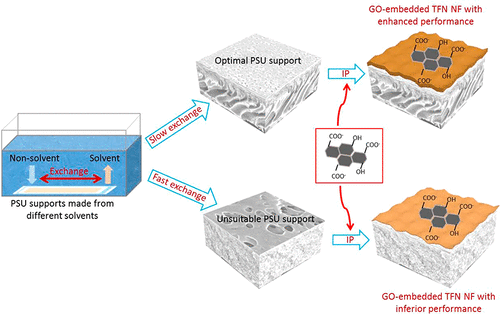当前位置:
X-MOL 学术
›
Ind. Eng. Chem. Res.
›
论文详情
Our official English website, www.x-mol.net, welcomes your
feedback! (Note: you will need to create a separate account there.)
Effects of Casting Solvents on the Morphologies, Properties, and Performance of Polysulfone Supports and the Resultant Graphene Oxide-Embedded Thin-Film Nanocomposite Nanofiltration Membranes
Industrial & Engineering Chemistry Research ( IF 3.8 ) Pub Date : 2018-11-13 , DOI: 10.1021/acs.iecr.8b04515 Quanling Xie 1, 2 , Shishen Zhang 1, 3 , Zhuan Hong 1, 2 , Hanjun Ma 1, 3 , Chenran Liu 1, 3 , Wenyao Shao 3
Industrial & Engineering Chemistry Research ( IF 3.8 ) Pub Date : 2018-11-13 , DOI: 10.1021/acs.iecr.8b04515 Quanling Xie 1, 2 , Shishen Zhang 1, 3 , Zhuan Hong 1, 2 , Hanjun Ma 1, 3 , Chenran Liu 1, 3 , Wenyao Shao 3
Affiliation

|
In this study, the influences of different casting solvents including N-methylpyrrolidinone (NMP), N,N-dimethylacetamide (DMAc), and N,N-dimethylformamide (DMF) on the morphologies, properties, and performance of polysulfone (PSU) supports and their resultant graphene oxide (GO)-embedded thin-film nanocomposite (TFN) nanofiltration (NF) membranes were systematically investigated. The influences of casting solvents on the mechanism of immersion precipitation phase-inversion process and the morphology of PSU supports were analyzed by Hansen solubility parameters. The results indicated that the physicochemical properties and performance of both PSU supports and the resultant composite NF membranes were significantly affected by the type of casting solvents. PSU support made from NMP exhibited a small surface pore size that prevented the penetration of poly(piperazine amide) (PPA) into the PSU pores, which contributed to form a defect-free active layer with excellent permeaselectivity regardless of TFC or TFN NF membranes. On the contrary, the surface pore size of PSU support made from DMF was too large to generate a dense and defect-free PPA active layer, which led to inferior rejection of the corresponding TFC or TFN membranes. After introducing an appropriate amount of GO into the aqueous phase, the nanocomposite active layer became thinner and smoother with enhanced hydrophilicity and negative charge. At a GO concentration of 40 ppm, TFN-NMP-GO-40 NF membrane exhibited excellent permeaselectivity, antifouling ability, and chlorine resistance compared with TFC-NMP membrane. Particularly, on the basis of retaining the high salt rejection (>98%) without a loss, the water flux of TFN-NMP-GO-40 membrane significantly increased to 46.9 L·m–2·h–1, which was 137.9% of the value for TFC-NMP membrane.
中文翻译:

浇铸溶剂对聚砜载体及嵌入石墨烯氧化物的薄膜纳米复合纳米过滤膜的形貌,性能和性能的影响
在这项研究中,不同铸造溶剂的影响包括N-甲基吡咯烷酮(NMP),N,N-二甲基乙酰胺(DMAc)和N,N系统研究了-二甲基甲酰胺(DMF)对聚砜(PSU)载体及其嵌入的氧化石墨烯(GO)嵌入的薄膜纳米复合材料(TFN)膜的形态,性能和性能的影响。通过Hansen溶解度参数分析了浇铸溶剂对沉浸相转化过程机理和PSU载体形貌的影响。结果表明,PSU载体和所得复合NF膜的理化性质和性能均受到浇铸溶剂类型的显着影响。由NMP制成的PSU载体的表面孔径较小,阻止了聚哌嗪酰胺(PPA)渗透到PSU孔中,无论是TFC膜还是TFN NF膜,都可以形成具有优异的通透选择性的无缺陷活性层。相反,由DMF制成的PSU载体的表面孔径过大,无法生成致密且无缺陷的PPA活性层,从而导致相应的TFC或TFN膜的排斥性能较差。在将适量的GO引入水相后,纳米复合活性层变得更薄更光滑,具有增强的亲水性和负电荷。在GO浓度为40 ppm时,与TFC-NMP膜相比,TFN-NMP-GO-40 NF膜表现出优异的通透选择性,防污能力和耐氯性。特别是,在不损失高盐分率(> 98%)的前提下,TFN-NMP-GO-40膜的水通量显着增加至46.9 L·m。由DMF制成的PSU载体的表面孔径太大,无法生成致密且无缺陷的PPA活性层,从而导致相应的TFC或TFN膜的拒收率降低。将适量的GO引入水相后,纳米复合活性层变得更薄更光滑,并具有增强的亲水性和负电荷。在GO浓度为40 ppm时,与TFC-NMP膜相比,TFN-NMP-GO-40 NF膜表现出优异的通透选择性,防污能力和耐氯性。特别是,在不损失高盐分率(> 98%)的前提下,TFN-NMP-GO-40膜的水通量显着增加至46.9 L·m。由DMF制成的PSU载体的表面孔径太大,无法生成致密且无缺陷的PPA活性层,从而导致相应的TFC或TFN膜的拒收率降低。将适量的GO引入水相后,纳米复合活性层变得更薄更光滑,并具有增强的亲水性和负电荷。在GO浓度为40 ppm时,与TFC-NMP膜相比,TFN-NMP-GO-40 NF膜表现出优异的通透选择性,防污能力和耐氯性。特别是,在不损失高盐分率(> 98%)的前提下,TFN-NMP-GO-40膜的水通量显着增加至46.9 L·m。这导致相应的TFC或TFN膜的排斥效果较差。将适量的GO引入水相后,纳米复合活性层变得更薄更光滑,并具有增强的亲水性和负电荷。在GO浓度为40 ppm时,与TFC-NMP膜相比,TFN-NMP-GO-40 NF膜表现出优异的通透选择性,防污能力和耐氯性。特别是,在不损失高盐分率(> 98%)的前提下,TFN-NMP-GO-40膜的水通量显着增加至46.9 L·m。这导致相应的TFC或TFN膜的排斥效果较差。将适量的GO引入水相后,纳米复合活性层变得更薄更光滑,并具有增强的亲水性和负电荷。在GO浓度为40 ppm时,与TFC-NMP膜相比,TFN-NMP-GO-40 NF膜表现出优异的通透选择性,防污能力和耐氯性。特别是,在不损失高盐分率(> 98%)的前提下,TFN-NMP-GO-40膜的水通量显着增加至46.9 L·m。与TFC-NMP膜相比,TFN-NMP-GO-40 NF膜表现出优异的通透选择性,防污能力和耐氯性。特别是,在不损失高盐分率(> 98%)的前提下,TFN-NMP-GO-40膜的水通量显着增加至46.9 L·m。与TFC-NMP膜相比,TFN-NMP-GO-40 NF膜表现出优异的通透选择性,防污能力和耐氯性。特别是,在不损失高盐分率(> 98%)的前提下,TFN-NMP-GO-40膜的水通量显着增加至46.9 L·m。–2 ·h –1,这是TFC-NMP膜值的137.9%。
更新日期:2018-11-14
中文翻译:

浇铸溶剂对聚砜载体及嵌入石墨烯氧化物的薄膜纳米复合纳米过滤膜的形貌,性能和性能的影响
在这项研究中,不同铸造溶剂的影响包括N-甲基吡咯烷酮(NMP),N,N-二甲基乙酰胺(DMAc)和N,N系统研究了-二甲基甲酰胺(DMF)对聚砜(PSU)载体及其嵌入的氧化石墨烯(GO)嵌入的薄膜纳米复合材料(TFN)膜的形态,性能和性能的影响。通过Hansen溶解度参数分析了浇铸溶剂对沉浸相转化过程机理和PSU载体形貌的影响。结果表明,PSU载体和所得复合NF膜的理化性质和性能均受到浇铸溶剂类型的显着影响。由NMP制成的PSU载体的表面孔径较小,阻止了聚哌嗪酰胺(PPA)渗透到PSU孔中,无论是TFC膜还是TFN NF膜,都可以形成具有优异的通透选择性的无缺陷活性层。相反,由DMF制成的PSU载体的表面孔径过大,无法生成致密且无缺陷的PPA活性层,从而导致相应的TFC或TFN膜的排斥性能较差。在将适量的GO引入水相后,纳米复合活性层变得更薄更光滑,具有增强的亲水性和负电荷。在GO浓度为40 ppm时,与TFC-NMP膜相比,TFN-NMP-GO-40 NF膜表现出优异的通透选择性,防污能力和耐氯性。特别是,在不损失高盐分率(> 98%)的前提下,TFN-NMP-GO-40膜的水通量显着增加至46.9 L·m。由DMF制成的PSU载体的表面孔径太大,无法生成致密且无缺陷的PPA活性层,从而导致相应的TFC或TFN膜的拒收率降低。将适量的GO引入水相后,纳米复合活性层变得更薄更光滑,并具有增强的亲水性和负电荷。在GO浓度为40 ppm时,与TFC-NMP膜相比,TFN-NMP-GO-40 NF膜表现出优异的通透选择性,防污能力和耐氯性。特别是,在不损失高盐分率(> 98%)的前提下,TFN-NMP-GO-40膜的水通量显着增加至46.9 L·m。由DMF制成的PSU载体的表面孔径太大,无法生成致密且无缺陷的PPA活性层,从而导致相应的TFC或TFN膜的拒收率降低。将适量的GO引入水相后,纳米复合活性层变得更薄更光滑,并具有增强的亲水性和负电荷。在GO浓度为40 ppm时,与TFC-NMP膜相比,TFN-NMP-GO-40 NF膜表现出优异的通透选择性,防污能力和耐氯性。特别是,在不损失高盐分率(> 98%)的前提下,TFN-NMP-GO-40膜的水通量显着增加至46.9 L·m。这导致相应的TFC或TFN膜的排斥效果较差。将适量的GO引入水相后,纳米复合活性层变得更薄更光滑,并具有增强的亲水性和负电荷。在GO浓度为40 ppm时,与TFC-NMP膜相比,TFN-NMP-GO-40 NF膜表现出优异的通透选择性,防污能力和耐氯性。特别是,在不损失高盐分率(> 98%)的前提下,TFN-NMP-GO-40膜的水通量显着增加至46.9 L·m。这导致相应的TFC或TFN膜的排斥效果较差。将适量的GO引入水相后,纳米复合活性层变得更薄更光滑,并具有增强的亲水性和负电荷。在GO浓度为40 ppm时,与TFC-NMP膜相比,TFN-NMP-GO-40 NF膜表现出优异的通透选择性,防污能力和耐氯性。特别是,在不损失高盐分率(> 98%)的前提下,TFN-NMP-GO-40膜的水通量显着增加至46.9 L·m。与TFC-NMP膜相比,TFN-NMP-GO-40 NF膜表现出优异的通透选择性,防污能力和耐氯性。特别是,在不损失高盐分率(> 98%)的前提下,TFN-NMP-GO-40膜的水通量显着增加至46.9 L·m。与TFC-NMP膜相比,TFN-NMP-GO-40 NF膜表现出优异的通透选择性,防污能力和耐氯性。特别是,在不损失高盐分率(> 98%)的前提下,TFN-NMP-GO-40膜的水通量显着增加至46.9 L·m。–2 ·h –1,这是TFC-NMP膜值的137.9%。











































 京公网安备 11010802027423号
京公网安备 11010802027423号